Archives :: Research :: MSA-St. Louis :: Civil War Records
Civil War Records from the St. Louis Circuit Court
The Missouri State Archives was awarded a $330,619 grant from the National Endowment for the Humanities(NEH) to make cases related to the Civil War available to the public before the war’s sesquicentennial in 2011. In making the award, NEH named this archival and conservation work a “We the People” project. This is a special designation for efforts that significantly advance the teaching, study, and understanding of American history and culture.
The Archives launched this project in October 2006, and completed it in August 2009. This project builds upon the work done and procedures established in the St. Louis Circuit Court Historical Records Project.
The Records
More than 230,000 St. Louis court documents from the Civil War era demonstrate how litigation exploded during the period - over 11,000 case files were examined by NEH-funded archivists for the 1866-1868 years (while State Archives professionals complete the 1861-1865 era). Many citizens sued for property confiscated or damaged by troops and bushwhackers. Others contested over their civil rights and liberties, especially the administration of loyalty oaths.
In this 1866 case (on a change of venue from Iron County, Missouri), Confederate General Sterling Price and future Governor John B. Marmaduke are among several being sued for conspiring to overthrow the U.S. government and for confiscation of property (valued at over $16,000) during Price's famous 1864 raid.
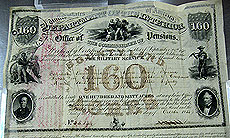
Processing confirmed the richness of the files in providing new insights into economic and social issues related to the war. The case files reveal complications involving the legal standing of debts incurred for the commerce of slavery, litigation among former slaves and freedmen, issues involving the legality of slave marriage prior to emancipation, disputes involving African American militia soldiers, and African American litigation in real estate.
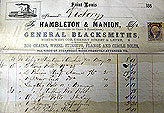
Steamboat commerce is
well documented in these
case files.
The legal decisions by provost marshals were called into judicial question, business partnerships dissolved over resistance to the U.S. government, lawyers argued over issues in the St. Louis-Alton area prisons, and domestic relations were strained to the breaking point. The litigation does not merely document the war and its aftermath in St. Louis. Due to changes of venue and long distance trading, the suits reach across geography - whether the events transpired in Phelps, Iron, or Washington Counties, Missouri; Van Buren, Arkansas; New Orleans, Memphis, and Vicksburg; or in Iowa, Kansas, Nebraska, and Montana Territory.
The archivists found a great deal of documentary evidence concerning the role of steamboat commerce on the Ohio, Mississippi, and Missouri Rivers - those in government service and other arrangements among merchants in St. Louis and several states in the 1860s.
Archival Processing
Preservation and access were the goals of the project. Conservators provided training for the newly hired archivists, and the staff worked cooperatively to establish procedures and meet project goals.
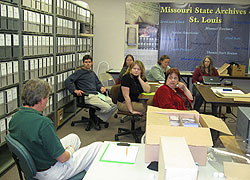
Conservators conducted a training session for
the new archivists and worked with them
to finalize procedures for the project.
All case files are arranged by year, term of court, and case number. Documents within each case file were reviewed for content and arranged chronologically by date filed.
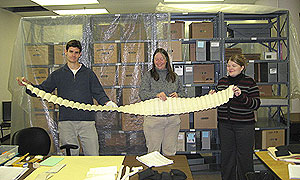
To date, this is the longest document
that has been found in the collection.
Oversized records were removed from the case files and stored separately in appropriate-sized folders and boxes to permit flattening, provide proper safe storage and handling, and access. Cross-references to the separated material are printed on alkaline paper and placed in the folders from which documents are removed.
Cases were verified against existing original court indices and record books. Each folder is labeled with the following information: record group, court type, series, year, term of court, case file number, plaintiff(s), defendant(s), cause of action, attorneys, notes (verdict, judgment, or final resolution, etc.), box and folder numbers.
All case files are housed in archival folders and document cases.
Conservation Treatment
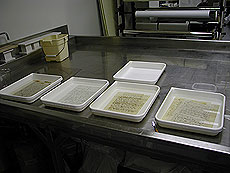
Glued documents are immersed in a bath of
deionized, alkaline water until the
adhesive begins to soften.
A large number of documents in this collection had been glued together along the top of the sheets, and in many cases the glue was applied in a way that obscures text. Since this restricts the archivists' ability to analyze the case and prevents satisfactory microfilming or digitization, all such documents were treated in the lab.
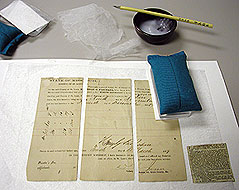
The conservators use wheat paste and handmade
Japanese paper to mend tears.
Badly damaged documents were transferred to the Archives' conservation lab, as are those that also contain significant historical information and are valuable as artifacts. The typical course of treatment includes testing and analysis, dry surface-cleaning, washing, removal of old mends (such as tape), and mending. Depending on the document's fragility and anticipated research use, the conservators may encapsulate it between Melinex or Mylar polyester sheets.
Improving Access
Initially, the only access to the cases was through the original direct and inverted indexes. While usable, these volumes are often in poor physical condition and provide only the most basic information: plaintiff and defendant names(s), year, term of court, and case file number.
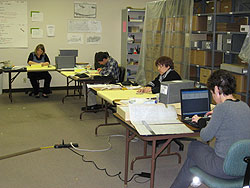
After archivists arrange and process the
collection, assistants input the information
into an Access database.
Archivists significantly enhanced access to the records through the creation of a comprehensive database index that contains a unique entry for each of the processed case files. This information includes provenance, a description of each case, and access information taken directly from the processed file folder.
Archivists also produce series descriptions that meet basic Encoded Archival Description (EAD) requirements and finding aids for related records series.
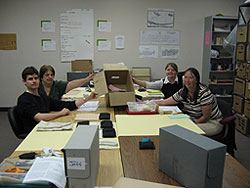
The NEH-funded archivists celebrated completion
of the first box of records in the project.
The database and files are located at the Missouri State Archives-St. Louis office.